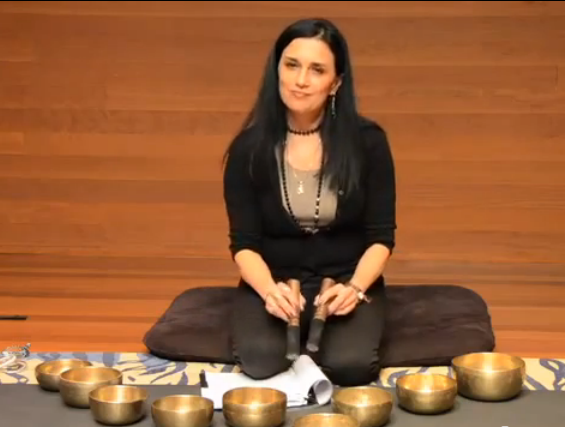
Tibetan Anthem; Tibetan Bowls
Share
December 21, 2012 - by Shakti
Recently, while reading about the immolations that have been spreading through Tibet, I came across a video on YouTube of the Tibetan National Anthem. Even though I have been in the Dharma community since coming to Southern California in 1994, I had never knowingly heard it played or sung. Of all of the Sutras I have heard and all of the Tibetan gatherings I have attended, no one had ever identified any piece of music as the anthem of Tibet. I didn’t know they had one. So when I found it on YouTube, I was surprised; when I heard it, I was captivated.
Known as Gyallu, the lyrics are based on the teachings of the Buddha. They are attributed to Trijang Rinpoche, who was a spiritual guide to the 14th Dalai Lama for some 40 years. Apparently, the lyrics were set to an ancient piece of sacred music; I would love to know the Sutra it comes from. The melody was sinuous and elevating, and seemed to exude hope. It had a hook in it, too. The first version I ran across was Camerata of St. John’s version, a brilliant performance with a soulful lead cello accompanied by intervals of violent string arrangements. It sounded like it was in the key of F#. I listened to it over and over.
For the past few years at Bodhisattva, it has been my pleasure to play Christmas carols on a set of Tibetan singing bowls and shoot a little video of it. So every year as the Christmas season approaches, I start mulling which Christmas carol I’d like to play. But by now it was late November, and Gyallu was staying with me. I was headed to The Rubin Museum in New York for their Serai event right after Thanksgiving. The more I thought about it, visualizing myself spending a week there, cocooned in its spiraling galleries of Himalayan Sacred Art, the less likely I was going to feel like playing “I heard the Bells on Christmas Day” on Tibetan bowls. As the immolations quickened, it seemed all the more important that this hymn should be heard.

So, Gyallu it was. The only trouble was going to be learning the melody in less than 7 days time, while flying to New York, setting up a booth at The Rubin Museum of Art, doing a five-day trunk show and giving some singing bowl workshops. I realized that as haunting as Gyallu was in the key Camerata had played it in, it was too hard a key for me. To begin with, I’m not at all gifted with the kind of ear where I can hear something once or twice and pick up on it. Learning Christmas carols on the Tibetan bowls is easy: I’ve heard those melodies since I was in the womb. Although this melody had very simple scales in it, it seemed labyrinthian to me.
We know that music is a mnemonic device. What I didn’t realize is how handy it is to have words to find our way around a piece of music. There wasn’t time to learn both. Finally, I found the music in a G major key which simplified learning the tune. I hadn’t had the occasion to read music since I was around 14, and this music was charted by a Westerner. Although I heard wide variations in the recordings by Tibetan artists, I used it as a guide. It goes something like this:
The short time frame meant that would mean I had to practice it at night. As I had to commute out to my friend’s house in Staten Island every evening, that meant lugging about 15 pounds of bronze bowls on the subway and the ferry each night. Which I did, plugging into a Tibetan version on YouTube while steaming past the Statue of Liberty. It was an emotional juxtaposition for me, these nightly sightings of our national symbol of freedom, listening to this song of spiritual liberation sung by a people who are not free to sing it in their own homeland. I contemplated our own violent path to independence, and wondered what path Tibet can take to spiritual and cultural freedom. It seems that the quest for Tibetan autonomy is perennially pushed off the front page, with no artillery or rockets to attract headlines. It is a quiet struggle, where monks as well as laypeople feel the imperative to be free is more important than life itself. I stared at Lady Liberty’s face. She is steadfast, resolute, fearless. She inspired me to never give up hope for Tibet.
Halfway through the Serai trunk show, I approached Dawn Eshelman, programming manager at The Rubin, and asked if it would be possible to shoot our video at The Rubin. Graciously, she and the Rubin management allowed us to use the theater Sunday, at the end of the workshop. Theo Dorian, a friend from numerous film classes in our college days, generously gave us his time to shoot. Susan Lamoureaux supported us with access to lighting and the Rubin’s remarkable sound system, and let us keep shooting til the Museum’s doors were closed. Prisanee Suwanwatana, manager of the Rubin Shop, very kindly made sure our booth was covered, and stayed late that night so we could pack up our Tibetan bowls and our gear. The staff at the Rubin were so amazingly supportive. My thanks to Tashi Choedron, the beautiful Tibetan museum tour guide, for her encouragement.
Although The Dalai Lama himself makes no call for Tibet’s independence from China in any way, he tireless asks of us to support Tibetans in their quest to win the basic human right to practice their religion in peace and to preserve their culture for future generations. If you would like learn more about what you can do to help, please visit International Campaign for Tibet.

